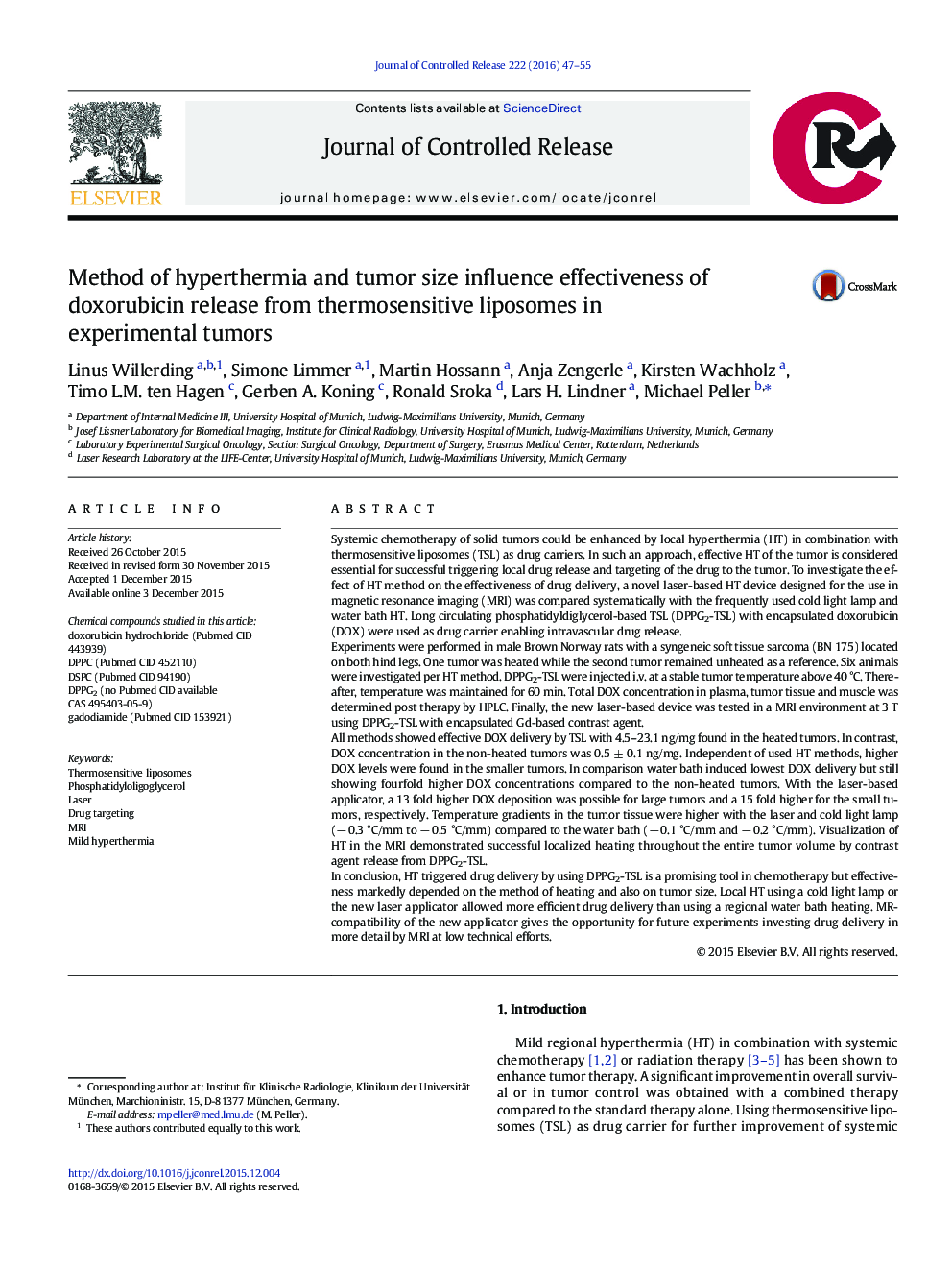| کد مقاله | کد نشریه | سال انتشار | مقاله انگلیسی | نسخه تمام متن |
|---|---|---|---|---|
| 1423600 | 1509027 | 2016 | 9 صفحه PDF | دانلود رایگان |
Systemic chemotherapy of solid tumors could be enhanced by local hyperthermia (HT) in combination with thermosensitive liposomes (TSL) as drug carriers. In such an approach, effective HT of the tumor is considered essential for successful triggering local drug release and targeting of the drug to the tumor. To investigate the effect of HT method on the effectiveness of drug delivery, a novel laser-based HT device designed for the use in magnetic resonance imaging (MRI) was compared systematically with the frequently used cold light lamp and water bath HT. Long circulating phosphatidyldiglycerol-based TSL (DPPG2-TSL) with encapsulated doxorubicin (DOX) were used as drug carrier enabling intravascular drug release.Experiments were performed in male Brown Norway rats with a syngeneic soft tissue sarcoma (BN 175) located on both hind legs. One tumor was heated while the second tumor remained unheated as a reference. Six animals were investigated per HT method. DPPG2-TSL were injected i.v. at a stable tumor temperature above 40 °C. Thereafter, temperature was maintained for 60 min. Total DOX concentration in plasma, tumor tissue and muscle was determined post therapy by HPLC. Finally, the new laser-based device was tested in a MRI environment at 3 T using DPPG2-TSL with encapsulated Gd-based contrast agent.All methods showed effective DOX delivery by TSL with 4.5–23.1 ng/mg found in the heated tumors. In contrast, DOX concentration in the non-heated tumors was 0.5 ± 0.1 ng/mg. Independent of used HT methods, higher DOX levels were found in the smaller tumors. In comparison water bath induced lowest DOX delivery but still showing fourfold higher DOX concentrations compared to the non-heated tumors. With the laser-based applicator, a 13 fold higher DOX deposition was possible for large tumors and a 15 fold higher for the small tumors, respectively. Temperature gradients in the tumor tissue were higher with the laser and cold light lamp (− 0.3 °C/mm to − 0.5 °C/mm) compared to the water bath (− 0.1 °C/mm and − 0.2 °C/mm). Visualization of HT in the MRI demonstrated successful localized heating throughout the entire tumor volume by contrast agent release from DPPG2-TSL.In conclusion, HT triggered drug delivery by using DPPG2-TSL is a promising tool in chemotherapy but effectiveness markedly depended on the method of heating and also on tumor size. Local HT using a cold light lamp or the new laser applicator allowed more efficient drug delivery than using a regional water bath heating. MR-compatibility of the new applicator gives the opportunity for future experiments investing drug delivery in more detail by MRI at low technical efforts.
Figure optionsDownload high-quality image (99 K)Download as PowerPoint slide
Journal: Journal of Controlled Release - Volume 222, 28 January 2016, Pages 47–55
